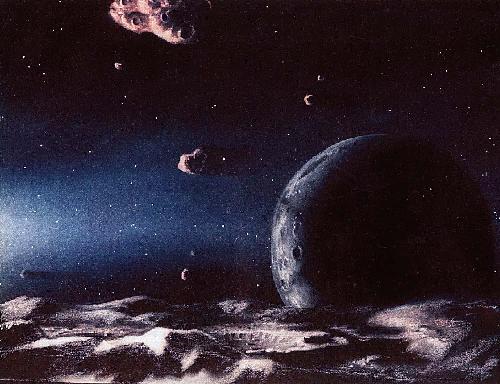 |
 |
|
| Comet | Jewitt | Kuiper |
|---|
| Moving the Orbits of Planets |
|---|
Introduction
Changing the sizes of the orbits of the planets - causing them
to "migrate" - is an
old idea whose time has come, both inside and outside
the solar system.
Evidence from Kuiper Belt
In the solar system, the resonant structure of the
Kuiper belt, particularly the existence of large numbers
of
Plutinos,
is best explained by "planetary migration".
In fact, the properties of the Plutinos can be used
together with a dynamical model to infer properties of
the migration including the direction (Neptune moved outwards)
the distance (Neptune moved about 7 or 8 AU) and the timescale
of the motion (probably 10 million years or so). How did this
come about?
The mechanism was first described in 1984 by Julio Fernandez and Wing Ip. In a one-planet solar system, the outward scattering of comets by the planet would cause the planet to spiral in towards the sun. In the real solar system, the motions of the planets are inter-dependent, causing some to move outwards and others inwards. What connects the planets is the transfer of comets (and angular momentum) from one to the other. Neptune scatters comets out to the interstellar medium and inwards, where some meet Uranus and are scattered again. The process repeats down to the innermost big planet Jupiter. Fernandez and Ip showed that massive Jupiter anchors the flow of angular momentum caused by the ejection of comets. It spirals towards the sun but Saturn, Uranus and Neptune drift outwards. It is the outward migration of Neptune that has had (apparently) observable effects on the Kuiper Belt by trapping the Plutinos.
A recent amplification of this idea of migrating planets is called the Nice Model.
Evidence from Extrasolar Planets
Meanwhile, the Doppler discovery of extrasolar planets orbiting very
close to their parent stars has raised a different problem. Many of
the planets are so close to their stars (<0.1 AU), and so hot, that
they cannot be supposed to have formed where we now observe them. By
inference, they could have formed at larger distances (several AU) and
then migrated inwards. What would cause this inward migration? As
with the solar system case, the root cause may be an exchange of
angular momentum with material surrounding the planets at their
formation. In particular, if the extrasolar planets formed in massive
disks, then torques between the planets and the disks could drive the
former inwards.
Aha, you say, why did they stop? There are several possible answers to this question (including the most brutally honest one "we don't know"). Indeed, they might not have stopped, in the sense that the observed close-in extrasolar planets could be the survivors from a now-defunct armada of planets that plopped into their stars never to be seen again. In this case, what we see is what was left behind after the planetary accretion disk dissipated and the tidal torques disappeared. Another possibility is that inward migration stopped when the planets reached the inner edge of the planetary accretion disk, because then the torques acting to propel them inwards would vanish.
Anyway, migrating planets are now in vogue. We need them to explain some of the dynamical structure we observe in the Kuiper Belt, and we need them to explain the unnervingly close-in planets detected around some other stars.
David Jewitt
 |
 |
|
| Comet | Jewitt | Kuiper |
|---|